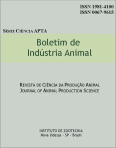Zootechnical performance of piglets submited or not to dental management
Keywords:
animal welfare, Sus domesticus, teeth removingAbstract
Currently the pig industry has undergone several adaptations, since the consumer is becoming more selective, especially with regard to food safety and animal welfare. Europe, the major consumer market of Brazilian pork, prohibits the practice of removing or wearing down of the teeth of piglets during the maternity, justifying this practice discourages the welfare of animals. On the other hand, in Brazil, this practice is still being performed routinely in most pig farms, which impairs the exportation of swine products to demanding markets. There is insuficient information about the harms and benefits of that management, so this study aimed to evaluate the influence of dental activity management on the performance of piglets during nursery. Twenty-six litters randomly distributed according to the order of birth of mother were investigated, being 13 litters subjected to dental management (control group), and 13 litters not subjected to the same management (treatment group). Each litter was evaluated for 21 days, undergoing piglets weighing on the day they were born and at 21 days occurred when weaning, thus to obtain the variables average daily weight gain (ADG) and weaning weight (WEIGHT). Regarding the ADG of piglets, the control group showed an average gain of 0.193 kg/day while the treatment group showed 0.200 kg/day, with no significant difference (P>0.05) between the experimental groups. For WEIGHT, the control group showed average of 5.685 kg, while the treatment group had 5.670 kg, also showing no statistically significant difference (P>0.05). There were no incidence of skin lesions and ceilings of the arrays and the skin of piglets evaluated that could be attributed to the implementation or not of dental management. Thus, by the results found in this study it may be recommended that the implementation of dental management happen only in cases where there is evidence of injury in piglets and/or on the ceilings of the arrays, thus avoiding unnecessary handlings on the farm.
Downloads
Downloads
Published
Issue
Section
License
Os autores não serão remunerados pela publicação de trabalhos, pois devem abrir mão de seus direitos autorais em favor deste periódico. Por outro lado, os autores ficam autorizados a publicar seus artigos, simultaneamente, em repositórios da instituição de sua origem, desde que citada a fonte da publicação original seja Boletim de Indústria Animal. A revista se reserva o direito de efetuar, nos originais, alterações de ordem normativa, ortográfica e gramatical, com vistas a manter o padrão culto da língua e a credibilidade do veículo. Respeitará, no entanto, o estilo de escrever dos autores. Alterações, correções ou sugestões de ordem conceitual serão encaminhadas aos autores, quando necessário. Nesses casos, os artigos, depois de adequados, deverão ser submetidos a nova apreciação. As opiniões emitidas pelos autores dos artigos são de sua exclusiva responsabilidade. Todo o conteúdo deste periódico, exceto onde está identificado, está licenciado sob a Licença Creative Commons Attribution (CC-BY-NC). A condição BY implica que os licenciados podem copiar, distribuir, exibir e executar a obra e fazer trabalhos derivados com base em que só se dão o autor ou licenciante os créditos na forma especificada por estes. A cláusula NC significa que os licenciados podem copiar, distribuir, exibir e executar a obra e fazer trabalhos derivados com base apenas para fins não comerciais.













